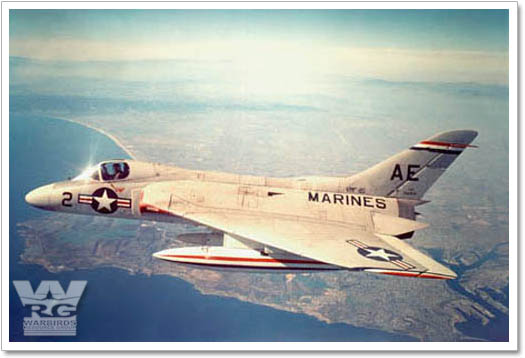U.S. NAVAL AVIATION RESOURCE CENTER > FIGHTERS > PREVIOUS PAGE

Douglas F4D-1 Skyray of Marine fighter squadron VMF(AW)-115 Able Eagles.
[Source: U.S. Navy)
The Skyray was designed to meet a Navy requirement issued in 1947 for a fighter aircraft capable of intercepting and destroying an enemy aircraft at an altitude of 50,000ft (15,240m) within five minutes of the alarm being sounded. The Navy also wanted an aircraft which followed the designs and research of the German aerodynamicist Alexander Lippisch who moved to the U.S. after World War II.
Design and Development
The F4D Skyray was a wide delta wing design with long, sharply swept, rounded wings. The design was named after the Manta ray fish which it resembled. The thick wing roots contained the air intakes feeding a single turbojet engine. Fuel was contained both in the wings and the deep fuselage. Leading-edge slats were fitted for increased lift during takeoff and landing, while the trailing edges were mostly elevon control surfaces. Additional pitch trimmers were fitted inboard near the jet exhaust, and were locked upward on takeoff and landing.
The Westinghouse J40 turbojet was the intended power plant, but Douglas fortunately took a conservative view and designed in contingency options for other power plants. The J40 proved troublesome and was eventually cancelled, and the Skyray was fitted instead with the Pratt & Whitney J57, a more powerful but larger engine.
Production aircraft were not delivered until early 1956, while the U.S. Marine Corps received their first in 1957. In total, 419 F4D-1 (later designated F-6 in the unified designation system) aircraft were produced.
Its unique and notable looks also played a part in making the Skyray one of the best-remembered early jet fighters. Affectionately known as the "Ford" (after the "Four" and "D" of its designation), this aircraft had a spectacular rate and angle of climb and set a new time to altitude record. It saw the Skyray fly from a standing start to 49,221 feet (15,000 meters) in 2 minutes and 36 seconds, all while flying at a 70 degree pitch angle.
Sources:
Wikipedia: Douglas F4D Skyray
U.S. NAVAL AVIATION RESOURCE CENTER > FIGHTERS > PREVIOUS PAGE
